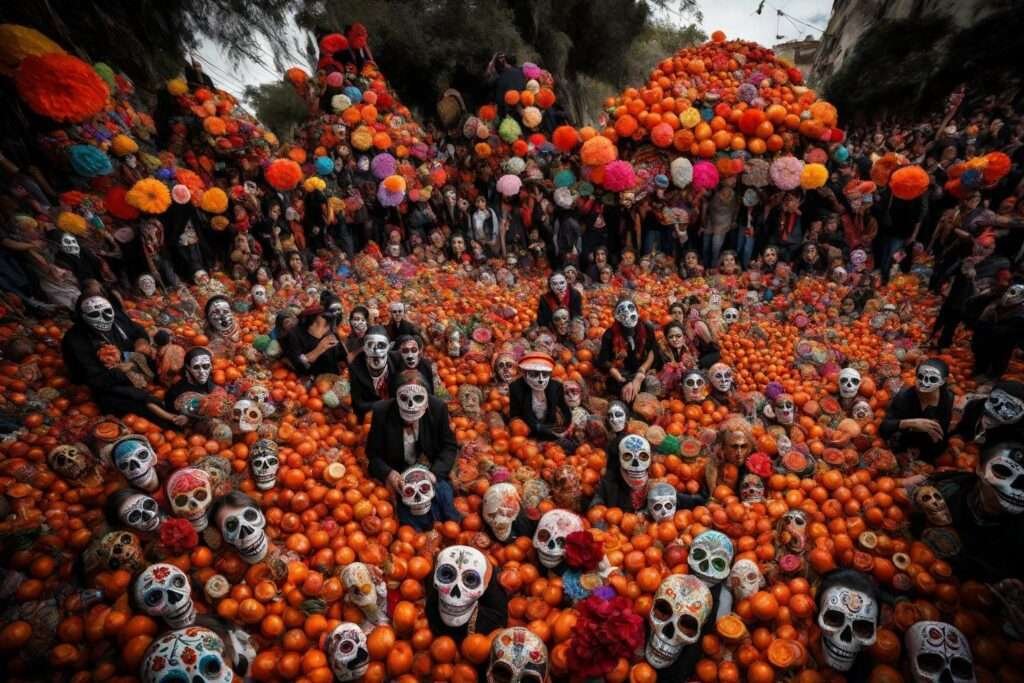Celebrating The Day of the Dead in Mexico: A Sensory Extravaganza

Introduction
Table of Contents
The Day of the Dead in Mexico is a vibrant and culturally rich celebration that engages all five senses. This traditional event, deeply rooted in pre-Hispanic culture, is a multisensory experience that brings people together to honor their ancestors and connect with their past. In this blog post, we will explore how this unique celebration engages the senses of sight, smell, taste, sound, and touch, making it a truly immersive experience.
The Scent of Cempasuchil and Copal Incense
Keywords: Cempasuchil, Copal Incense, Scent of Mexico, Multisensory Experience
Discover the captivating scents of cempasuchil flowers and copal incense that fill the air during Mexico’s Day of the Dead celebration, engaging your sense of smell in a unique way.
The Day of the Dead in Mexico is known for its distinctive aromas. The scent of cempasuchil flowers, also known as marigolds, and the copal incense permeates the air. These scents are not just pleasant; they hold deep cultural significance. Cempasuchil, whose name means “flower of 20 petals” in Náhuatl, exudes a fragrance so strong that it almost seems to speak to you, inviting you to partake in the celebration. The copal incense, burned at altars, adds a mystical layer to the olfactory experience, guiding the souls of the departed back to the living world.
A Feast for the Palate
Keywords: Day of the Dead Food, Orange Blossom Bread, Traditional Offerings, Taste of Mexico
Culinary traditions play a central role in the festivities of the Day of the Dead in Mexico..
Culinary traditions play a central role in the festivities of the Day of the Dead.. From the sweet bread flavored with orange blossom to the symbolic offerings of Mother Earth, this tradition offers a taste of Mexican culture that is both intriguing and delicious. Interestingly, the origins of some of these foods are quite remarkable. According to some, the sweet bread was historically prepared by mixing honey and even human blood as an offering to the gods. Others believe that Spanish colonizers, appalled by human sacrifices in Mexico, created a red, sugar-dipped bread to symbolize a heart. Today, on the altars, there is a special place for the deceased’s favorite food and drink, as it’s believed that the essence of what they consume is what nourishes their souls when they return to the world of the living.
Resonance of Sound
Keywords: Mariachi Music, Sound of Celebration, Musical Offerings, Mexican Cemeteries
The Day of the Dead is not just about visual and olfactory experiences; it’s a symphony of sound. Mariachi music, with its vibrant melodies and passionate lyrics, fills the air as families gather at cemeteries to celebrate with their departed loved ones. Some even hire mariachi bands to serenade their ancestors, creating a joyful and spirited atmosphere. The sounds of trumpets, guitars, and singing blend with the scent of marigolds and the taste of traditional food, making this celebration a truly multisensory experience.
Crafting Art with Papel Picado
Keywords: Papel Picado, Traditional Crafts, Artistic Expression, Cultural Symbols
Dive into the world of traditional Mexican crafts with papel picado, intricate paper cut-outs that add a touch of artistry to the Day of the Dead celebration.
Papel picado, or intricately cut colored paper, is an essential element of Day of the Dead altars. This traditional craft is a labor of love, often created by skilled artisans who meticulously cut out intricate designs by hand, eschewing stencils or laser cutters. While some associate its origins with amate tree bark used as paper by pre-Hispanic communities, others believe it was influenced by Chinese paper-cutting techniques introduced to Mexico by Spanish colonizers. Regardless of its origins, papel picado symbolizes the union between life and death. The scenes and designs on these delicate paper cut-outs often depict dancing or feasting skulls and skeletons, adding an artistic dimension to the celebration.
Beyond the Senses
Keywords: Cultural Syncretism, Visual Spectacle, Remembering Ancestors, Multifaceted CelebrationMeta Description (160 characters): Explore the multifaceted celebration of the Day of the Dead, where cultural syncretism, visual spectacles, and remembrance converge to create a unique experience that goes beyond the senses.
The Day of the Dead is a celebration that transcends the ordinary. It engages all five senses, allowing you to see, smell, taste, hear, and touch the rich tapestry of Mexican culture and tradition. Beyond the sensory experience, it’s a celebration that connects people with their heritage, and keeps the memories of the departed alive for generations to come. Beyond the senses, the Day of the Dead is a celebration that is deeply ingrained in the Mexican DNA. From the moment people are born, they experience this unique celebration, and it becomes a
part of their identity.

Conclusion
The Day of the Dead in Mexico is a celebration that engages all the senses, providing a sensory tapestry of sight, smell, taste, sound, and touch. It’s a celebration that goes beyond the physical and into the spiritual realm, connecting the living with the departed and keeping traditions alive. Explore this extraordinary celebration, and immerse yourself in the vibrant and sensory world of the Day of the Dead in Mexico. Whether it’s the vibrant colors, the fragrant scents, the delectable flavors, the resonating music, or the intricate art, the Day of the Dead offers a sensory experience like no other, a true celebration for the five senses and the soul.

